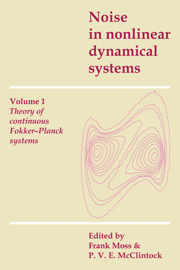Book contents
- Frontmatter
- Contents
- List of contributors
- Preface
- Introduction to Volume 1
- 1 Noise-activated escape from metastable states: an historical view
- 2 Some Markov methods in the theory of stochastic processes in nonlinear dynamical systems
- 3 Langevin equations with colored noise
- 4 First passage time problems for non-Markovian processes
- 5 The projection approach to the Fokker–Planck equation: applications to phenomenological stochastic equations with colored noises
- 6 Methods for solving Fokker–Planck equations with applications to bistable and periodic potentials
- 7 Macroscopic potentials, bifurcations and noise in dissipative systems
- 8 Transition phenomena in multidimensional systems – models of evolution
- 9 Colored noise in continuous dynamical systems: a functional calculus approach
- Appendix: On the statistical treatment of dynamical systems
- Index
4 - First passage time problems for non-Markovian processes
Published online by Cambridge University Press: 05 January 2012
- Frontmatter
- Contents
- List of contributors
- Preface
- Introduction to Volume 1
- 1 Noise-activated escape from metastable states: an historical view
- 2 Some Markov methods in the theory of stochastic processes in nonlinear dynamical systems
- 3 Langevin equations with colored noise
- 4 First passage time problems for non-Markovian processes
- 5 The projection approach to the Fokker–Planck equation: applications to phenomenological stochastic equations with colored noises
- 6 Methods for solving Fokker–Planck equations with applications to bistable and periodic potentials
- 7 Macroscopic potentials, bifurcations and noise in dissipative systems
- 8 Transition phenomena in multidimensional systems – models of evolution
- 9 Colored noise in continuous dynamical systems: a functional calculus approach
- Appendix: On the statistical treatment of dynamical systems
- Index
Summary
Introduction
This book is a reflection of the recent interest in the correlation properties of fluctuations driving linear and nonlinear systems. The interest arises because fluctuations in physical systems are never truly white and because of the sensitive dependence of certain system properties on these correlations. In the last few years a number of theoretical techniques have been proposed for the proper treatment of colored noise in stochastic systems. Also, a number of experiments have been designed to explore the effects of color on system response.
In this chapter we concentrate on one class of properties that are particularly responsive to the color of the noise that drives a physical system. The first time T(xp) that an evolving stochastic physical process X(t) reaches a preassigned value xp is called the first passage time and depends sensitively on the correlation properties of the noise. Of course the first passage time T(xp) is itself a statistical quantity and is characterized by a distribution function f(t) as distinct from the distribution P(x, t) for the state variable.
The first passage time from an initial state X(0) = x0 to xp is sensitive to the distribution density P(x, t) for values of x covered by X(t) as it evolves from x0 to xp. The biggest contributions to T(xp) arise from those portions of a trajectory for which P(x, t) is small. These improbable regions of phase space through which the trajectory passes are the most difficult to traverse and therefore contribute most to the first passage time.
- Type
- Chapter
- Information
- Noise in Nonlinear Dynamical Systems , pp. 110 - 160Publisher: Cambridge University PressPrint publication year: 1989
- 10
- Cited by



